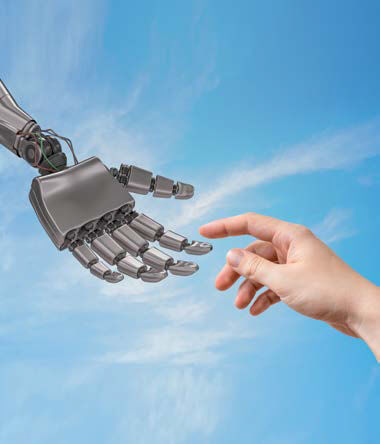What’s humanly possible
Helen checks into a hotel, versions one and two. In version one, I reach the desk with a sigh, let my bag slip to the floor and stand there passively while the check-in clerk goes through the routine, looking even more world-weary than I feel. It’s slick enough – all the details are accurately logged in on the system – but feels so joyless that it seems to take an eternity.
Once I get to my room, though, there is a personal salutation – on the TV screen. ‘Welcome Helen Edwards’ it says, in big, colourful capitals, against a vague sort of seascape scene. Do I feel better now? More valued? Less beaten down by my day on the road?
No. Whatever the cognitive systems that have been working with silent efficiency behind my booking, this crude attempt at artificial empathy does nothing but prompt me to reach for the remote. Artificial it certainly is; but empathy went missing when the hotel’s operations team thought they could separate out human warmth and zap it down the wires.
What about version two? It’s a similar mix of carbon-based life and silicon smarts, but with more of an organic flow. There are smiles. The personal greeting happens at the desk: “Ah, welcome back Mrs Edwards, I see we have a lovely room for you away from the elevators, as we have here on your profile. Oh, and I see from the pre-log that you’ve had a pretty long flight; would you like me to get your bags sent up while I arrange for some… er, yes, some green tea in the lounge?”
It’s not like she has remembered all my personal proclivities like an old-fashioned maître d’ who recognised a thousand faces, knew what their aperitif would be and could probably name their first-born. She and I both know that the computer does the background scraping and she takes her cues from there. But it works. I feel empathised with. Valued. Suddenly not so beaten up by my day.
In version two, the fusion of cold technology and human warmth has produced an agreeable customer experience.
There’s a lot out there at the moment about how artificial intelligence (AI) will – despite all the foreboding – bring more ‘humanity’ to business. The front cover of London Business School Review, the school’s quarterly magazine for alumni, flags a lead article on ‘what success will look like in the age of AI’, under the bold title ‘The Future is Human’.
The question marketers need to ask is: why not the present? Humbler strata of digital capability already exist, yet few brands use them to full effect to enhance or humanise the customer experience.
In those two hotel check-ins – both recent and both in places I’d stayed before – the customer data systems would have been similarly standard. Yet only in one did it feel like marketers got anywhere in on the decisions – ensuring that data was used to meaningfully personalise the experience, training front-line staff to interpret information with empathy and giving them the freedom to make instant, unapproved decisions.
 Marketers who find themselves on work streams exploring new digital business systems need to be the ones not to get overexcited by the CES-style capabilities coming down the line, but to bring the conversation back to what could be more imaginatively done with what already exists.
Marketers who find themselves on work streams exploring new digital business systems need to be the ones not to get overexcited by the CES-style capabilities coming down the line, but to bring the conversation back to what could be more imaginatively done with what already exists.
There is no shame in taking inspiration from the best examples out there. With high streets shrouded in gloom, I am always amazed at how few retailers have adopted the technology-enabled ‘walking checkout’ system used in Apple stores.
They smile. They come up to help when you’re looking and deliberating. They advise, order up from stock, take payment, email the invoice and even book you in for coaching should you want it. All on the spot, with the aid of an adapted iPhone.
Meanwhile, down the road in places such as Next, people are penned in queues for the privilege of paying and told, even for low-value purchases, ‘sorry, we don’t do contactless’.
Unexceptional technology can also be used to make brands more responsive to consumers’ sense of personal rhythms. On Norwegian long-haul flights, passengers can order food and drink when their body clock tells them to, rather than waiting for a trolley service at pre-set times.
The orders are placed by customers from their seat, using interactive touchscreens with images of the drinks and snacks on board. This may be low-cost flying, but the feeling is that the cabin crew are coming up personally to serve you, within minutes of your order, rather than just passing along for everyone with a carb load on wheels.
‘This changes everything’ is the phrase that’s always used to herald the latest technological advances; it’s being said now about 5G telecommunications and 3D printing.
But in the daily experiences of consumers, some things never seem to change: people still wait too long in lines, still get nonsensical responses from bots with names like Samantha or Abigail and still stand at hotel check-in desks feeling like a unit to be ‘processed’.
Marketers should wake up and find ways to change these everyday irritations with the help of the technological resources on hand today. Then, as new intelligent systems come along, we should use them not to replace front-line staff, but to free them up to show customers a lot more care.
The future may not play out like that, of course. For all I know, the machines will become ever more intuitive and brands will simply outsource those empathetic nods, asides and smiles to them. But as both a consumer and a marketer, I know which version I prefer.
Too many ‘service’ brands pay only lip service to delivering a great customer experience, often falling back on the ‘our people are just lovely’ platitude. Here are some that have broken through and created distinctiveness through a systematic and imaginative approach to ‘people power’.
RITZ-CARLTON
Although over 10 years old, this case study is used in business schools worldwide – the gold-standard example for demonstrating how treating your own people with respect is the starting point for ensuring that they deliver wonderful, respectful service to customers. ‘We are ladies and gentlemen serving ladies and gentlemen’ is the hotel brand’s long-standing motto.
It is brought to life in numerous ways, including how the company treats people who are rejected for a job; the everyday language codes, such as ‘my pleasure’, which are used at all levels of the organisation; and the execution of ‘instant guest pacification’, where staff are empowered to break away from their activities whenever they see a problem, and to solve it. Simple stuff, but still frustratingly rare.
ZAPPOS
The legendary ‘powered by service’ online shoe retailer was founded in 1999 and sold to Amazon in 2009 for around $1.2bn (£939m). The shoes may be nothing out of the ordinary but the human interaction is.
There are no limits on call times – the longest reported call is over 10 hours – and employees are free to give ‘surprise upgrades’ to overnight shipping. The brand’s core values, including ‘create fun and a little weirdness’, set the tone for a business that prioritises making work enjoyable – which probably explains why it boasts lower levels of staff turnover than similar call centre-led companies.
FIRST DIRECT
Ever since it launched in 1989, the niche bank has found itself at the top of most UK customer service rankings. Famous for its call centre ‘adult conversations’, it seems to be able to seamlessly integrate and humanise new technology: it was the first bank to introduce voice ID and the first with a Twitter account.
SOUTHWEST AIRLINES
Describing itself as ‘a customer service company that happens to fly aeroplanes’, Southwest pioneered the ‘not stuffy, just friendly’ approach to flying. Herb Kelleher, co-founder and chairman until his death in early January, was a great advocate for hiring people for warmth and friendliness, rather than just their skill set. He encouraged a ‘warrior spirit’ with a ‘servant’s heart’ and, in a po-faced sector, embodied the brand’s signature ‘fun-loving attitude’.
